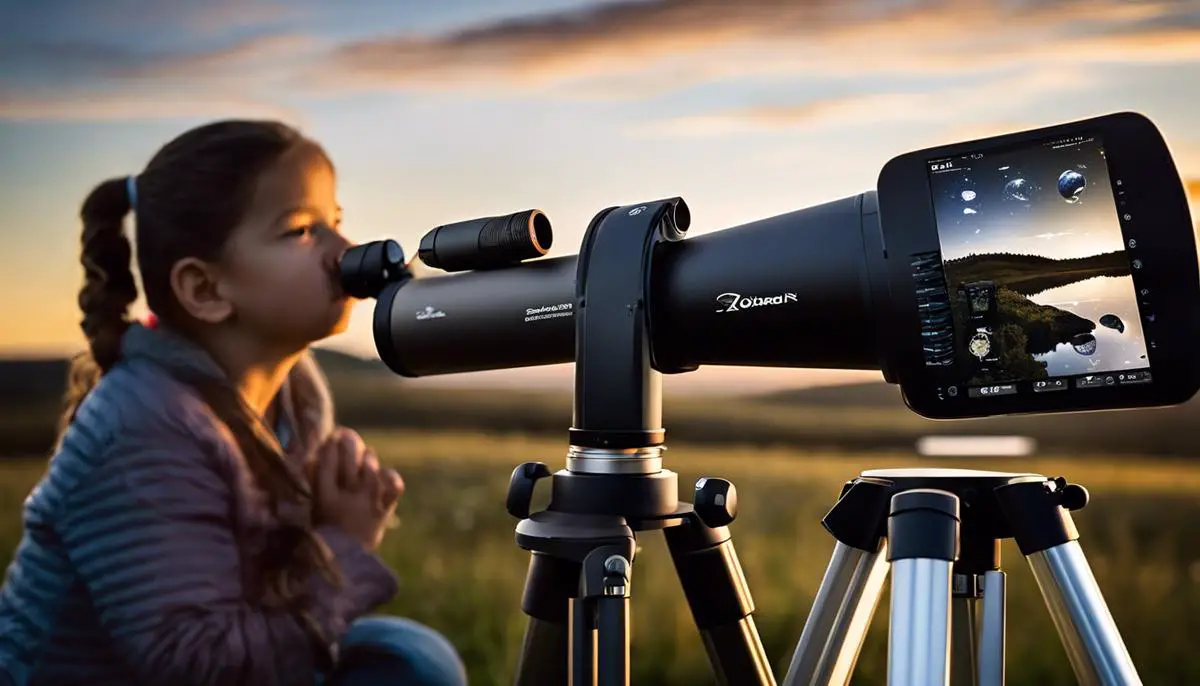Exploring the cosmos has never been more accessible to families than it is today, thanks to the evolution of user-friendly telescopes designed for stargazers of all ages. The wonders of the night sky hold a special fascination and engaging with them can be a bonding educational experience for the entire family. However, diving into the world of astronomy shouldn’t require an advanced degree in astrophysics. In this exploration, we delve into the criteria that make a telescope truly user-friendly — ease of setup, minimal maintenance, and straightforward usage. We’ll examine models featuring automated mounts, GoTo functionality, and intuitive interfaces, ensuring that your journey among the stars is both enlightening and enjoyable without the daunting technical barriers.
Criteria for User-Friendliness
User-Friendly Telescopes: A Guide for Family Stargazing
Stargazing has always been a beloved family activity, allowing both young and old to gaze upon the celestial wonders of the night sky. However, an intricate part of making this experience truly mesmerizing lies in selecting a telescope that is user-friendly for families. But what exactly makes a telescope approachable for the occasional backyard astronomer and their eager companions?
First and foremost, a family-friendly telescope should boast a straightforward setup. Time spent fumbling with complex assembly can dampen enthusiasm and deter budding young astronomers. Look for models that feature a ‘no-tool’ setup, meaning everything snaps into place effortlessly or requires minimal effort to get started.
Next, the ease of use cannot be overstated. A telescope for families should offer intuitive controls. Telescopes with simple altazimuth mounts are preferable for beginners as they move up and down, left and right, making it a breeze to track stars and planets across the sky. An added bonus is the presence of a sturdy mount—a shaky view through the eyepiece can lead to frustration and a less-than-stellar stargazing experience.
Optical quality is crucial, yet it’s the combination of crisp, clear images with a user-friendly design that wins for families. A telescope with a smaller aperture – around 70mm to 90mm – usually suffices for moon craters, planets, and bright deep-sky objects. A good balance between portability and power ensures the equipment is manageable for younger users without compromising on the quintessential awe-inspiring view.
Additionally, high-tech features such as computerized ‘GoTo’ mounts, which automatically align and direct the telescope to thousands of celestial objects, are fantastic for families. That said, it’s vital these features don’t complicate the experience. A user-friendly interface on the accompanying software is essential, ideally one that’s compatible with a family’s existing smartphone or tablet.
Educational resources bundled with the telescope can also greatly enhance the user experience for families. Interactive apps, detailed celestial maps, and user guides specifically catered to children can make a world of difference in transforming stargazing into not just a hobby, but a learning adventure.
Last but not least, durability must be factored into the equation. A family-friendly telescope should withstand the occasional bump or spill during those precious moments of discovery. A robust, well-crafted body with a protective coating is the hallmark of a telescope ready to serve a family for years to come.
Considering these pivotal points—ease of assembly, straightforward operation, balanced optical capabilities, engaging technological features, educational value, and durability—a telescope can indeed be deemed user-friendly for families. Such an instrument can transform the night sky into an endless playground of stars, planets, and galaxies, ensuring that the age-old tradition of family stargazing continues to inspire wonderment in the hearts of tomorrow’s astronomers.

Best Telescopes for Families
Best Telescopes for Family Stargazing: A Guide to the Stars
Embarking on a celestial adventure from the backyard is an enriching experience for families, but the choice of telescope can make or break the stargazing journey. For those seeking the perfect balance of user-friendliness and stellar viewing capabilities, certain models rise above as clear leaders in the amateur astronomy community.
The Celestron NexStar 130SLT gains favor for its combination of robust features and manageable size. This reflector telescope, with a 130 mm aperture, captures ample light to dazzle users with detailed views of the Moon’s craters, the rings of Saturn, and even distant galaxies. Navigating the night sky is a breeze, thanks to its refined ‘GoTo’ mount with a database of over 40,000 celestial objects. Families can engage with astronomy without the frustration of intricate setup procedures—alignment is straightforward, and the telescope swiftly locates sought-after sights.
For those with a penchant for portability, the Orion StarBlast 6i IntelliScope impresses. The compact design doesn’t compromise on viewing pleasure, featuring a sizable 150 mm aperture that offers bright and clear images. Its IntelliScope computerized object locator lets users pinpoint over 14,000 heavens’ marvels at the push of a button. While not a full ‘GoTo’ system, the ease with which novices can navigate makes it a family favorite. Parents who intend to introduce young minds to astronomy appreciate this model for its user-friendliness and educational potential.
The Meade Instruments Infinity 102AZ refractor is a prime candidate for families that value simplicity without sacrificing quality. The refractor design provides sharp, high-contrast images and requires little maintenance. With a 102 mm aperture, it captures less light than larger options but still offers satisfying views of the moon and planets. Its altazimuth mount with slow-motion controls allows for smooth tracking of celestial bodies, which is particularly helpful when sharing the view with eager, young skywatchers.
No discussion about stargazing tools for families is complete without mentioning the Sky-Watcher 8” Classic 200P Dobsonian. Its 203 mm aperture is a window to the cosmos, presenting clusters, nebulae, and galaxies in splendid detail. The Dobsonian mount, known for its stability, also ensures that even the most enthusiastic children won’t accidentally disrupt the view. This telescope is a bit heftier, but it is still transportable for those memorable nights under the stars at remote dark-sky locations.
Finally, assessing the inclusions of educational resources is paramount. Several manufacturers bundle astronomy software, star maps, and instructional guides, enriching the learning experience. Using the Stellarium planetarium software, for instance, can transform stargazing into an informative tour of the night sky, enhancing the adventure for the entire family.
Selecting the ideal telescope extends beyond the specs on paper; it’s about finding the gateway to the universe that aligns with the family’s curiosity and desire for discovery. Each telescope listed offers reliable performance and the potential for countless evenings spent exploring the cosmos together. With these options, families can embark on their stargazing odyssey, assured the technology will facilitate, not hinder, their celestial expeditions.

Innovative Features in Modern Telescopes
Transforming a simple night under the stars into an educational odyssey, technology has redefined the family stargazing experience. Advanced features of modern telescopes complement the natural curiosity of both kids and adults alike, allowing for evenings filled with discovery and awe. The integration of technology into these instruments of the cosmos offers an opportunity to engage with astronomy in profoundly new ways.
A quintessential element is the integration of smartphone apps with telescopes. By bridging the gap between celestial navigation and digital convenience, these applications offer a seamless guide to the heavens. Users can simply point their device to the sky, and the app not only identifies stars and planets but can also control the telescope to align with the celestial body of interest. This symbiotic relationship between app and telescope offers a foolproof method for locating and learning about constellations and galaxies.
Moreover, the digital realm extends its reach to enhance education through augmented reality (AR) experiences. Families can utilize AR apps to overlay informative graphics and text onto the night sky’s canvas, providing context to what’s observed. This immersive experience brings a depth of information to the visual spectacle, turning each stargazing session into both a lesson and a narrative.
Another leap forward comes from astrophotography, a luxury once exclusive to professional astronomers, now accessible to amateurs through technological advancements. Cameras with connectivity to telescopes capture the subtlest details of the Milky Way or the rings of Saturn. With user-friendly software, these interstellar snapshots can be shared instantly, making an exhilarating family adventure even more memorable.
Additionally, advancements in light pollution reduction technology are indispensable for urban families. Filters and specially designed optics allow telescopes to mitigate the glow of city lights, revealing celestial objects that would otherwise be lost in the glare. This ensures that even those far from the serene darkness of the countryside can partake in the joys of stargazing.
Finally, the collective knowledge of the astronomy community is integrated into the software of many contemporary telescopes. By harnessing databases and algorithms, these intelligent systems recommend the most spectacular celestial events tailored to the user’s location and time. It’s like having a personal astronomer within the device, ensuring that families won’t miss out on these ephemeral skywatching opportunities.
In the grand scheme of things, the interplay of technology with family stargazing is not merely about seeing more stars; it’s about deepening the understanding and appreciation of the universe. It enables every outing to be a blend of fascination and insightful reflection, giving a new dimension to the act of looking up and pondering the cosmos. Through technology, the ancient practice of stargazing is thus revitalized, beckoning a new age of cosmic exploration for families.

The cosmos is full of wonders waiting to be discovered, and with the right telescope, families can unlock the mysteries of the night sky together. Modern telescopes blend sophisticated technology with simplicity, bringing the universe closer to home. They prove that you don’t need to compromise on quality to find a device that’s accessible to every member of the family. While advances such as smartphone integration and augmented reality options are enhancing the experience, the true joy lies in the shared moments of awe as celestial objects come into view for the first time. It’s about creating memories and nurturing a sense of curiosity and discovery — which is after all, what astronomy is all about.
![]()
